读写任务:概括
读写任务型写作模版
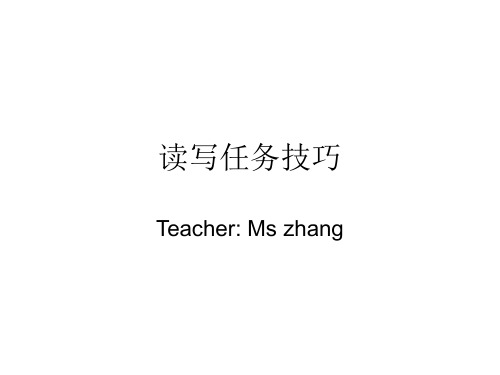
阶段并不需要加上个人的见解 写作具体方法和要求: 第一段概括要做到开门见山: 例如: 1.)According to the passage, we know… 2).This article is mainly about… 3).The writer states that… 4) The writer tells us …
近邻。... There are several reasons why I think so. Firstly, ….secondly… 第三段: Ina word…
第二段接开头语进行阐述
• 议论文: firstly,…secondly,…what’s more/what’s worse…. in addition For one thing…. For another thing On one hand…on the other hand…. 记叙文常常以一件事例进行阐述。
读写任务技巧
Teacher: Ms zhaFra bibliotekg读写任务型写作模板
标题
第一段:概括所给短文内容要点约27--40字
第二段:过渡词引出主题句---自己的观点---理 由 [约80--95字]
第三段:总结句 [约35--40字] 字数一定不要少于150字即15行左右。
• 读写任务步骤:
• (一)审读阅读材料[寻找作者的论点,论据和结论] • (二)概括原文观点[转述作者的论点,论据和结 论] • (三)提出自己观点[赞成或反对] • (四)论证自己观点[用事例论证自己的观点] • (五) 得出结论
标题
• 标题是段落中心思想的精练表达形式。根 据所写短文的内容,概括出中心思想然后 加以提炼,拟定标题;
On Smoking How to make friends Happiness Neighbors Are Important
英语读写任务写作的步骤

英语读写任务写作的步骤英语读写任务写作的步骤二、概括原文观点:转述作者的论点,论据和结论;三、提出自己观点:赞成或反对,观点要鲜明,不能自相矛盾;四、论证自己观点:用事例论证自己的观点;五、得出结论:表示时间顺序的:First,later,next,then,finally,before,after,soon,previously,immediately,formerly原来,subsequently随后,meanwhile,presently目前,initially最初,ultimately最后,表示举例的:Forexample,forinstance,suchas,表示列举的':And,firstly,second,third,last,another,next,finally,furthermore表示补充的:Also,inaddition,and,further,another,aswellas,besides,too,either,表示比较或反差的:比较类like,likewise,similarly,as,atthesametime,aswellas,incomparison,both,all反差类ontheotherhand,incontrast,however,but,inspiteof,despite,nevertheless,onthecontrary,instead,rather,though,yet,regardless,although,unlike,eventhough,whereas,表示强调的:Importanttonote,most,aboveall,especiallyvaluable,acentralissue,especiallyrelevant,shouldbenoted,themostsubstantialissue,rememberthat,amajorevent,theprincipalitem,payparticularattentionto,thechieffactor,mostofall,asignificantfactor,aprimaryconcern,akeyfeature,themainvalue,。
summary写作指导

读写任务概要(summary)写作指导30字概要的基本四大技巧:Skill1: Omit (省略) the details Skill2: Omit the examplesSkill3: Use general(概括性) words instead of specific(具体的) wordsSkill4: Put the main points of a dialogue in indirect speech (间接引语,第三人称)第一类:记叙文(1)记叙文的概要, 一般包括记叙文的六个要素(who; when; where; what; how; why), 也就是考生应先通读阅读短文,找出这六个要素,然后用自己的话将这六个要素串成一两句话即可。
当然, 不一定每篇记叙文都包含这六个要素,但“某人做了某事, 结果如何”是应当包括的。
因此, 要写好概要, 需找到以下两个问题的答案:1)谁做了什么?(who did what)2)结果如何?(what was the result)☆特别提醒:如果是夹叙夹议的文章,还要找主题句或利用“写作内容”给出的提示,写出故事给我们的启示、教育或其中的一个道理。
(2)记叙文概要的参考模版:The story is about …, from which (启示)......The passage mainly tells us that …, which shows that(启示)......The author thinks / points out / tells us / holds the view that …, through w hich(启示)......According to the article, we know that …We can see from the text …As can be seen from the text, …[例文]阅读下面短文, 然后按要求写一篇150词左右的英语短文。
“读写任务”中概括大意的策略

Wh : o W h t a: W h n: e Whr: ee Ho w: Th e s l : er u t h ie ’ pi o T e wrtr S o nin:
h me: T e Ar u n : g me t 1 S p o n e a l1: u p si g d t i Ar me t2: u g n S p o n e ml2: u p ai g d t Co c u i n: n lso
高中
20 0 8年 第 7・ 8期
13 2
维普资讯
p a e o s i h a .  ̄r h i h a lc n my l t r d y Be e t e br d y. 1 e a b t t r d w( k
o tapln wih my pae s u a t rnt.W eplne o ha i e o a d t ve dnn rt—
p o ie t gve me a e rm sd o i n w M P p a e . Ho ve 3 ly r we r, s m eh n u x ce ha e d n ha d y 1 o t i g ne pe td pp ne o t t a . we t n
二 、 策 略 指 导
1 写什 么 ( a t w i ) . wh t o r e。 t
要写 “ 摘要 ” ,首 先得知道 要写什 么 ,也就 是必须弄 清楚 什 么是 文章 的内容要 点 ,如何找 出来 。读 写任务 中要求考生 阅
读 的文 章主要有三种 文体 :记叙文 、议论文 和说 明文。这三种
英 语 胜 经
c m o e i 4 od ) o fr dhm.( 0w rs t
读写任务笔记背默
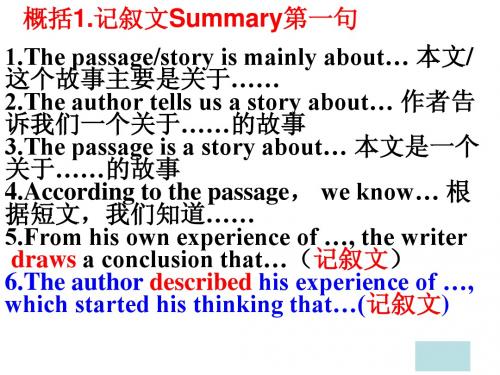
进行列举的常用词汇 (这里是举例,不是经历) For one thing, …. For another, …. On one hand,…. On the other hand,….. A contributing factor is that….. Another equally important aspect is that… To begin with/First of all,… What’s more,…. In addition,…. Last but not least,…. 举例子常用句式 A good case in point might be given easily. A particular example for this might be given easily.
Such examples might be given easily.
▲2.说出体会和感受 I was deeply inspired by such a story, as it makes me realize the importance of a goal… 这个故事让 我深受启发,因为它使我意识到设立目标的重要 性…… (2010揭阳二模) From the story I have learned that the trials of life are of great importance in our growth. 通过这个 故事,我领悟到生活的考验对我们的成长是非常 重要的。(2010茂名一模) This story teaches us that we should not judge people only by their appearance. 这个故事告诉我 们,我们不应当仅凭外表来判断人。(2009广州二 模)
高考英语读写任务基本写作模板

高考英语读写任务基本写作模板标题第一段: 概括所给短文内容要点[约30字]第二段: 渡词引出主题句---自己的观点---理由[约100字]第三段: 总结句[约20字]标题标题是段落中心思想的精练表达形式。
根据所写短文的内容,概括出中心思想然后加以提炼,拟定标题;Is time more valuable than moneyOn SmokingHow to make friendsHappinessIs watching TV a good thing?My view of money / time / pollutionMy attitude toward building a car factory…第一段:概括所给短文内容要点注意利用原文中所给的语言材料,用自己的话来写;概括后的文章意思要通顺,行文要连贯。
写作具体方法和要求:1. 第一段概括要做到开门见山,要抓住要点, 语言精练。
例如:1) According to the passage, we know…2) This article is mainly about…3) The writer states that…4) As can be learn this passage,5) As the passage says that………2. 第二段要做到有层次感:过渡词引出主题句---自己的观点---理由。
必要时概括段中运用firstly,…secondly,…lastly,…或…but…, so…等来列出原文作者观点或内容。
第二段的开头用语:I do agree with the a uthor…In some way, I agree with …, but…This opinion sounds right but is hardly practical.It is definitely not like that. As a matter of fact, …From my personal angle alone…In my opinion,…From my personal point of view…As far as I’m concerned…It reminds me of …I also experience such a …before. When I …As to me…第三段[最后一段]总结句开头用语:In conclusion,…In short,…To make a long story short,…In general,…In a word,…In belief,…On the whole,…All in all,To sum up ,In brief,…读写任务请阅读下面这篇新闻报道,然后按照要求写一篇150词左右的英语短文。
读写任务
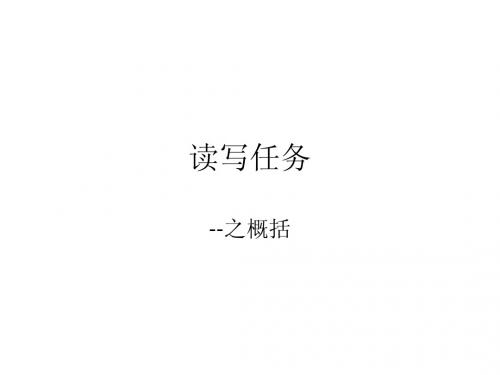
• The big day finally came . On arriving home ,Jim was surprised to find Della’s long hair cut short .But Della was also surprised to find Jim’s gold watch gone .She had sold her hair to buy a gold watch chain for him ! He had sold his gold watch to buy an expensive comb for her ! • The gifts were now useless .But in fact they got the best gifts .
In the last few years, however, more and more students have started studying in groups. There are several reasons many students prefer this method. First, they find that studying is more fun as they can share the experience with others rather than staying in their rooms. In groups, they can discuss the subject together and when something is not understood they can ask each other questions. They can use the knowledge of their classmates to help improve their own knowledge. Finally by discussing the topic they, are able to both understand and remember it better.
高中英语读写任务主旨大意概括专项训练

读写任务中的主旨大意怎么写?▼ 分准项目分值评分标准5按照要求概括了全部主要信息, 没有增加与原文无关的信息, 没有照抄原文的句子。
语言结构正确,行文规范。
4基本按照要求概括了主要信息, 没有增加与原文无关的信息, 没有概照抄原文的句子。
语言结构正确,行文规范。
3基本按照要求概括了主要信息, 但包含一些不相关的信息, 有个别句子抄自原文。
语言结构基本正确,行文比较规范。
括2不能按照要求概括主要信息, 包含较多不相关的信息, 有较多的抄袭原。
语言结构不够正确,行文不够规范。
0— 1没有按照要求概括主要信息, 基本是不相关的信息, 大多数句子都照抄原文。
语言结构不正确,行文不规范。
▼概括的写作步:1、找关文章的关可合“写”的任中的“就⋯⋯”主表自己的看法的要求来确定。
如,要求你“以120你理想的大学生活”,那么所的文章的主就是“college/university life。
”2、确定主句。
文章的主句首先可通所材料的来确定,材料的即是文章的点或主句。
没有的文章,我就尤注意文、叙文和明文的第一段(起段)和最后一段(段),或每一段的第一句或第二句(起句)和最后一句(句)。
没有主句的需要自己合。
3、重构主句。
概括的主句要性,能涵盖后面所有的支撑句的内容。
4、重支撑句。
支撑句的意在上受制于主句,是充程或者提供据。
常策略1.无法抓住短文要点a.仔全文b.找出关(句)2.无法脱原文句子c.理清关(句)的关系d.借助关,用自己的言恰当地概括要点。
▼概要句型模板1.According to the passage, we know that...From the passage, we can know that...2.In this passage, the writer / author states / thinks / argues that...3.In this passage, the writer/author tells us about...4.The story / passage is about...▼以下是常见文体的主题句及主要内容的概括的方法和技巧。
高三英语读写任务作文专题突破summary

高三英语读写任务作文专题突破---如何写概括30个词的摘要怎么写?Part I. 什么是摘要?A summary is a short account giving the main points of something longer or detailed.概括部分包含几种能力。
第一要看清楚文章的结构,设法反映出原文中作者的观点。
第二要具有意义筛选的能力,学会区分事实和观点、重要和次要、普遍与特殊、相关与不相关、原因和结果等复杂的逻辑关系。
第三要有用英文解释英文的能力,用自己简单的语言解释比较复杂的语言文字,不能抄袭原文。
一、概括的标准:抛弃次要,瞄准写作目的。
标准的概括采用浮凸式的表达方式,第一句话是主题句,清楚明白地告诉了读者文章的写作目的,这句话的质量决定了概括的成败。
后面的句子对主题句进行解释和支撑,凡是意义在主题之外的要毫不吝啬地予以删除。
二、概括的写作步骤:1. 确定主题句。
确定阅读文章的主题句,一般在段首。
没有主题句的需要自己组合。
2. 寻找关键词。
分析主题句意义,确定关键词,关键词一般体现为名词、形容词,关键词的数目决定了概括的信息浓度。
3. 重构主题句。
概括的主题句逻辑上要统摄后面所有的支撑句。
可以从作者的写作目的逆推,反映写作目的主题句是高度抽象的,它基本决定了概括的质量。
4. 重组支撑句。
支撑句的意义在逻辑上受制于主题句,可以是补充过程或者提供证据。
口诀:简括为:缩长见短,省却细腻。
(括:概括性。
见:间接引语。
短:短的连词。
细腻:细节和例子)三、概括的形式:“主题句+支撑句” 即“主题+主题的什么”。
文体主题句支撑句议论文文章论点(一句)文章论据(两三句)故事大意(两三句)记叙文故事的写作目的/ 主题(一句)说明文说明的对象/ 观点/ 现象解释/ 分述附:广东高考概括部分评分细则:1.完全糊涂地照抄原文,连人称都不改的,得0分;2.机械死板地照抄原文,只改人称的,得1分;3.稍微灵活地抄原文,改主语,宾语、原文词序的,得2分;4.创造性地抄,改主语,宾语、原文词序还有句子结构的,最多得3分。
概括内容要点(Summary)的方法及技巧

概括内容要点(Summary)的方法及技巧关键词:读写任务,概括,内容要点,中心句(topic sentences),关键词(Key words),分类,方法及技巧,针对性训练。
摘要:针对广东省英语高考的变化,结合2008年广东省各地模拟试题的读写任务的具体分析,就如何指导学生在读写任务写作中的概括短文的内容要点谈谈我的做法及几个小技巧。
为了加大对考生语言综合能力,语言驾驭能力的考查,2007年广东省英语高考对题型进行了大幅度的调整:作文增加至两篇,包括基础写作和读写任务写作。
本文从命题特点来看,读写任务写作一般包括以下几个内容:1.以约30个词概括短文(约200词)的内容要点;2.以约120个词写一篇短文,包括以下要点:1)你的看法或观点2)举例说明或说明理由3)你的做法,建议等从评分标准来看,概括部分(即文章的第一段)占5分,要求“按要求概括了全部主要信息,没有增加与原文无关的信息,没有照抄原文句子。
语言结构正确,行文规范。
”好的开头是成功的一半,作文更是如此。
文章的第一段甚至第一个句子往往影响了评卷老师的主观印象。
若想应试作文拿高分,第一段在很大程度上奠定了这篇文章的档次。
那么,怎么做到满分的内容要点的概括呢?第一、审清题目要求。
题目要求概括全文的内容要点最为常见,但也有更具体的。
如,2007年广东卷读写任务,要求概括父母对“我”的希望;2008年佛山二模,要求概括作者喜欢与朋友共处的原因等等。
因此,审清楚题目要求是非常重要的。
技巧之一:注意关键词(题眼)并使用适当的英文词汇表达。
如上述2007广东卷,关键词是“希望”,因此必须要用“hope”或“expect”表达出来;同理,2008佛山二模,关键词是“原因”,必须使用“because”或“reason”表达出来。
又如,新闻报道类,必须使用“report”或“It’s reported that”。
第二、训练学生找出文章的主题句(topic sentences)或关键词(Key words)。
读写任务

读写任务解题方法一、确定标题不管好坏,一定要有标题,标题是文章的点睛之处。
根据所给材料和所规定的论题或要点确立自己论述的内容或观点后进行命题。
命题要体现真篇文章议论的中心。
如:Opinions towards Fast Food/ Is Failure a Bad Thing?/Learn from Mistakes等。
二、进行概括概括文章要点,语言要精炼,概括要全面,行文要连贯,表达要准确。
议论文则用自己的话表达论点、论据和结论。
概括常用的句式有:1.This article deals with/discusses/analyzes/strongly emphasizes…2.This article not only describes …but also suggests…3.This article compares…and summarizes key findings…4.This articles gives an account of/provides an analysis of/provides a method of…5.The article reports the last information on…6.The problem of sth. Is discussed…7.This articles shows/tells us that…8.The author finds it necessary to…9.The author holds the idea that…giving it an example of sb. who…10.The author strongly emphasizes the benefits of getting up early such as…三、自然过渡写完概括后,用句恰当的过渡语引出自己的观点(反对或赞成)。
过渡语起承上启下的作用,使文章显得自然、连贯。
概括学案

专题复习——读写任务的概括Florence Chadwick was a great swimmer. However, not all of her efforts worked out. In addition to working hard, she had a secret for success. At the age of 34, her goal was to become the first woman to swim from Catalina Island to the California coast. However, in 1952, the sea was like an ice bath and the fog was so dense that she could hardly see her support boats. Her body was numb(麻木) and she had been swimming for nearly 16 hours. Against the cold grip of the sea, she struggled on—hour after hour—while millions watched on national television. Alongside Florence, in one of the boats, her mother and her trainer offered encouragement. They told her it wasn’t much farther. But all she could see was fog. They urged her not to quit. She never had…until then. With only a half mile to go, she asked to be pulled out. Still warming her chilled body several hours later, she told a reporter, “Look, I’m not excusing myself, but if I could have seen land I might have made it.”It was not tiredness or even the cold water that defeated her. It was the fog. She was unable to see her goal. Two months later, she tried again. Despite the same dense fog, she swam with her faith intact(未受影响的)and her goal clearly pictured in her mind. She knew that somewhere behind that fog was land and this time she made it!【写作内容】以约30个词概括短文的要点。
读写任务中的概要写作三招
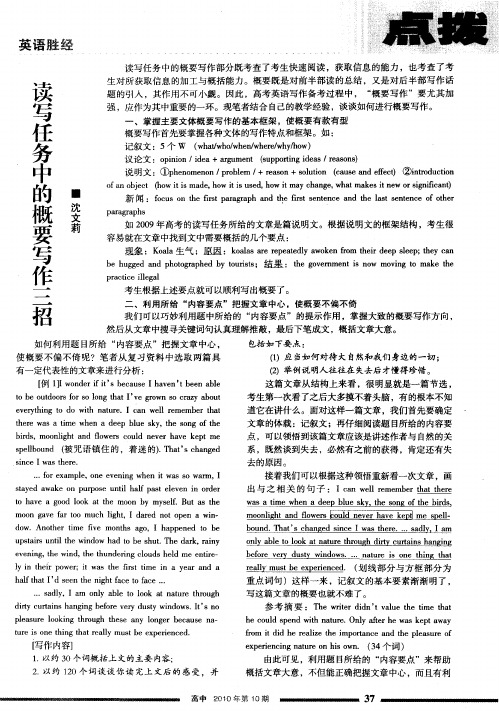
这 篇文章从结构上来 看 ,很 明显就是一篇 节选 , 考生第一次看 了之后大多摸不着头脑 ,有 的根本不知 道它在讲什么。面对这样一篇文章 ,我们首先要确定 文章 的体载 :记叙文 ;再仔细 阅读题 目所给的内容要 点 ,可 以领悟到该篇 文章应该是讲述作者与 自然的关
如何利用 题 目所给 “ 内容要 点”把握文章 中心 , 使 概要不偏 不倚 呢?笔者从 复 习资 料 中选 取两篇 具
包括 如 下要 点 :
()应 当如何对待大 自然和我 们身边的一切 ; 1
( 2 )举例说明人 往往在 失去后 才懂得珍惜。
有一定代 表性 的文章来进行分析 :
wa i h n a d e l e s y h o g o e b r s sat me w e e p b u k ,te s n ft i , h d
sa e wa e n p po e u i af p s lv n i r e ty d a k o ur s ntlh l a tee e n o d r
说明文 :( hn m n n po l +rao  ̄p e o eo / rbe m, esn+slt n cueade et ( it d c o oui as n f c  ̄ nr u t n o ) ) o i
■
o bet h wiimae hwii ue, o y h ne w a m k st e r i icn f nojc o d, o sd hwima ag, h t a e wo g f at a ts ts t c in s ni ) 新 闻 : f u ntefs p arp n efs snec n I at etneo te o so h r a g ha dt rt etneadtels snec f hr c itr a h i l o
英语任务型读写常用的概括性词汇及经典取代
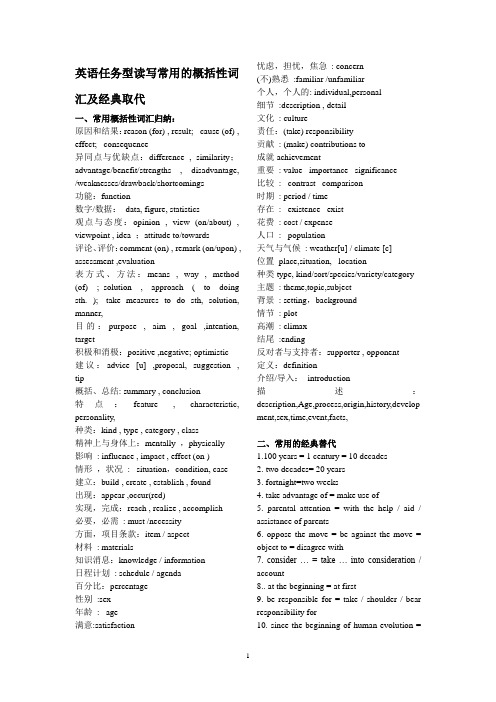
英语任务型读写常用的概括性词汇及经典取代一、常用概括性词汇归纳:原因和结果:reason (for) , result; cause (of) , effect; consequence异同点与优缺点:difference , similarity;advantage/benefit/strengths , disadvantage, /weaknesses/drawback/shortcomings功能:function数字/数据:data, figure, statistics观点与态度:opinion , view (on/about) , viewpoint , idea ;attitude to/towards评论、评价:comment (on) , remark (on/upon) , assessment ,evaluation表方式、方法:means , way , method (of) ; solution , approach ( to doing sth. ); take measures to do sth, solution, manner,目的:purpose , aim , goal ,intention, target积极和消极:positive ,negative; optimistic建议:advice [u] ,proposal, suggestion , tip概括、总结: summary , conclusion特点:feature , characteristic, personality,种类:kind , type , category , class精神上与身体上:mentally ,physically影响: influence , impact , effect (on ) 情形,状况: situation,condition, case 建立:build , create , establish , found出现:appear ,occur(red)实现,完成:reach , realize , accomplish必要,必需: must /necessity方面,项目条款:item / aspect材料: materials知识消息:knowledge / information日程计划: schedule / agenda百分比:percentage性别:sex年龄: age满意:satisfaction 忧虑,担忧,焦急: concern(不)熟悉:familiar /unfamiliar个人,个人的: individual,personal细节:description , detail文化: culture责任:(take) responsibility贡献: (make) contributions to成就achievement重要: value importance significance比较: contrast comparison时期: period / time存在: existence exist花费: cost / expense人口: population天气与气候: weather[u] / climate [c]位置place,situation, location种类type, kind/sort/species/variety/category 主题: theme,topic,subject背景: setting,background情节: plot高潮: climax结尾:ending反对者与支持者:supporter , opponent定义:definition介绍/导入:introduction描述:description,Age,process,origin,history,develop ment,sex,time,event,facts,二、常用的经典替代1.100 years = 1 century = 10 decades2. two decades= 20 years3. fortnight=two weeks4. take advantage of = make use of5. parental attention = with the help / aid / assistance of parents6. oppose the move = be against the move = object to = disagree with7. consider … = take … into consideration / account8.. at the beginning = at first9. be responsible for = take / shoulder / bear responsibility for10. since the beginning of human evolution =throughout human history11. in search of better job opportunities. = seeking a better job. / searching /looking /hunt for a better job.12. housing-related reasons = reasons related / linked/relevant to / connected with housing 13. take an active part in = take part in sth. actively14. encourage participation in quiet activities = encourage children to participate in / take part in/ play a role in quite activities15. be hooked on headphones = be addicted to headphones16.valuable information = information of great value17.understand clearly = have a clear understanding of sth.18.affect = have an effect / influence / impact on sth.19.matter = count = be very important = be of importance = make sense = make a difference 20.be over = end = put …to an end= come to an end21.despite = in spite of22. share less than 2% = account for less than 2%= make up23.online = on the Internet24.learn good citizenship = learn to be good citizens25.list the things that you are good at = list what / all you are good at26.explain sth. = make an explanation27.enjoy sth = get pleasure from; take pleasure in28. besides = on top of = in addition to = apart from = as well as29. be better than = be superior to30. approve of = subscribe to = be in favor / support of = favor sth.31.have access to = be acceptable / accessible / available to32.stop = quit = give uppensate for = make up for34.in part = partly 35.every year = yearly = annually = on a yearly basise up = run out of (主动)37.run out = give out = be used up (被动)38.be accused of = be charged with39.most of the people = the majority of the people40.cater to /for one’s needs / demands /requirements = satisfy / meet one’s ….41.starve to death = die of hunger/ starvation drown to death = die of drowning42.be tired out = be worn out = be exhausted = be weary43.socially responsible = social responsibility44.sth. benefit sb. = be beneficial to sb. = be of benefit to = sb. benefit from sth .mit oneself to doing sth. = promise to do sth.46.make full use of = make the most \ best of47. be proud of = take pride in48. never...anthing more than=nothing more than49. in secret = secretly in total = totally in peace = peacefully in surprise = surprisedly in a hurry = hurriedly in brief = briefly 50. offer sb sth = provide sb with sth = provide sth for sb = supply sth to sb51. apologize to sb for sth =make an apology to sb.= say sorry to sb52. turn sb down = refuse sb happen=take place53. increasingly popular = more and more popular54. change rapidly = a rapid change55. shared interests=common interests56. keep\bear...in mind = remember57. sb takes\shows (an) interest in / sb. be interested in =sth appeals to sb58. as a result of = because of。
读写任务中概要写法分类例说
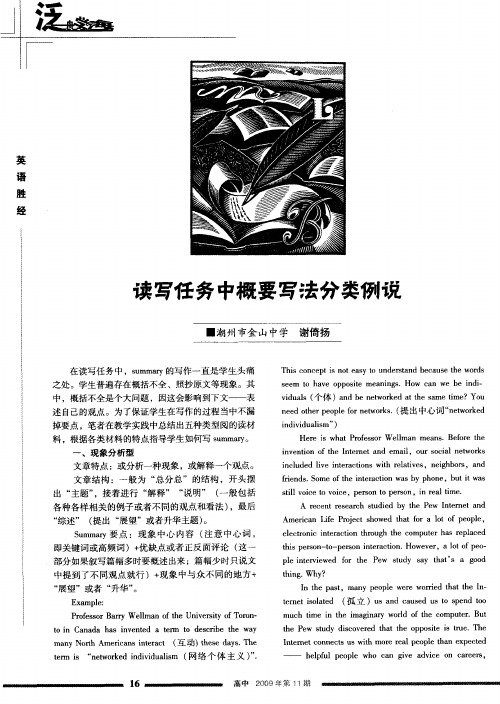
T
y ・
I I e e e lt e . e mb r lb r g i h o f v rf e i d Ir me e a o n n t e h t r i
中提到 了不 同观 点就行 )+ 现象 中与众 不同 的地 方+
“ 展望”或者 “ 升华 ” 。
Ex mpl: a e
tre i l e ( 立 )U n asdU p n o e ts a d 孤 u ot Sa dcue St sedto o
mu h t n t e i gn r r ft e c mp t r u c i me i h ma i a wo l o h o u e .B t y d t e P w su y d s o e e h t t e o p s e i t e h e h e td i v r d t a h p o i s r .T c t u
T a k o t e c mp tr w r be t b ln h n s t h o ue , e a e a l o e ao e
20 0 9颦 篱 1 期 1
◆ ■■ ▲
随
l
f
me ia p o lms rii g h lr n, a d h o i g d c l r be , a sn c i e d n c o sn a s h o r c l g .A o t6 l o me ia st l e c o lo ol e b u 0 mi i n A r n od P w e l c
中,概括不全是个 大问题 ,因这会影响到下文——表
概括的基本步骤
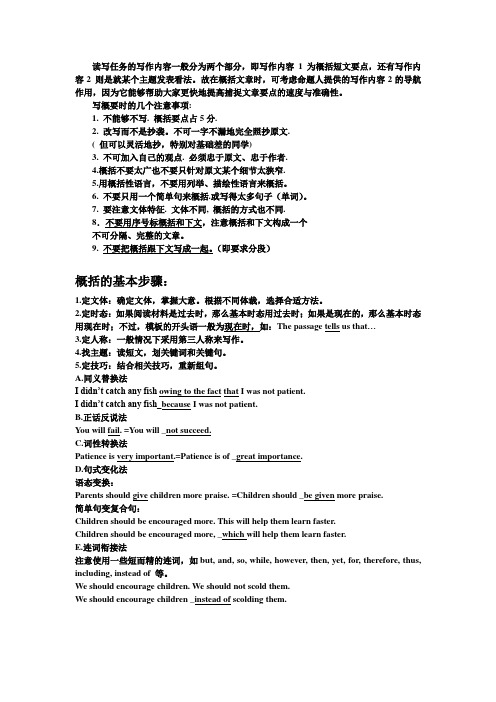
读写任务的写作内容一般分为两个部分,即写作内容1为概括短文要点,还有写作内容2 则是就某个主题发表看法。
故在概括文章时,可考虑命题人提供的写作内容2的导航作用,因为它能够帮助大家更快地提高捕捉文章要点的速度与准确性。
写概要时的几个注意事项:1. 不能够不写. 概括要点占5分.2. 改写而不是抄袭。
不可一字不漏地完全照抄原文.( 但可以灵活地抄,特别对基础差的同学)3. 不可加入自己的观点. 必须忠于原文、忠于作者.4.概括不要太广也不要只针对原文某个细节太狭窄.5.用概括性语言,不要用列举、描绘性语言来概括。
6. 不要只用一个简单句来概括.或写得太多句子(单词)。
7. 要注意文体特征. 文体不同, 概括的方式也不同.8.不要用序号标概括和下文,注意概括和下文构成一个不可分隔、完整的文章。
9. 不要把概括跟下文写成一起。
(即要求分段)概括的基本步骤:1.定文体:确定文体,掌握大意。
根据不同体裁,选择合适方法。
2.定时态:如果阅读材料是过去时,那么基本时态用过去时;如果是现在的,那么基本时态用现在时;不过,模板的开头语一般为现在时,如:The passage tells us that…3.定人称:一般情况下采用第三人称来写作。
4.找主题:读短文,划关键词和关键句。
5.定技巧:结合相关技巧,重新组句。
A.同义替换法I didn’t catch any fish owing to the fact that I was not patient.I didn’t catch any fish_because I was not patient.B.正话反说法You will fail. =You will _not succeed.C.词性转换法Patience is very important.=Patience is of _great importance.D.句式变化法语态变换:Parents should give children more praise. =Children should _be given more praise.简单句变复合句:Children should be encouraged more. This will help them learn faster.Children should be encouraged more, _which will help them learn faster.E.连词衔接法注意使用一些短而精的连词,如but, and, so, while, however, then, yet, for, therefore, thus, including, instead of 等。
- 1、下载文档前请自行甄别文档内容的完整性,平台不提供额外的编辑、内容补充、找答案等附加服务。
- 2、"仅部分预览"的文档,不可在线预览部分如存在完整性等问题,可反馈申请退款(可完整预览的文档不适用该条件!)。
- 3、如文档侵犯您的权益,请联系客服反馈,我们会尽快为您处理(人工客服工作时间:9:00-18:30)。
Last but not least, take regular medical examines to check out the potential eye disease and prevent its deterioration(退化). Eyes are the most important sense organs and one should use proper eye care products to avoid further irritations (刺激)and ensure longevity长命,长寿at ease安心;自在;不拘束 .
Besides those notices, you should be aware of some threats to eyes in daily lives. Excessive exposure to bright sunlight is harmful to eyes, therefore, when going out, especially in summer time, put on a pair of qualified sunglasses. Stay away from smoking. Some ingredients组成部分;(烹调的)原料 in cigarettes are carcinogenesis(致癌的).
第三步:用自己的话将其串联起来。参考范 文如下: 范文1:Sam could not get used to the life of the boarding school, and he thought his parents hated him and left him in it, which made him sick, angry and lonely.
我们根据说明文的不同类型, 分别给出 三种参考模板: 1. 描写某事物的性质功用。即“对象+性 质功用+利好”: (In the passage) the writer introduces... (对象)to us, especially its...(性质或功用), from which we know...(对象带来的利好).
第二步, 用自己的话将其表达出来。参考 范文为: (范文1) The passage mainly tells us getting up early in the morning is a good habit that will benefit us a lot. It enables us to have a better memory, healthier body and better preparation for the day.
如果是夹叙夹议的文章, 还要加上这个故事 给人们的启示或教育。
[例1](2011年广东) [写作内容] 1. 以约30个词概括上文的主要内容; 2. 以约120个词讲述一次你(或你的朋友)想 家的经历。
解题过程 第一步, 根据[写作内容2], 快速获取大意。 解题前, 可以通过[写作内容2]和材料文 体,快速准确地把握阅读材料的主要内容并 形成概要的基本框架。如本题阅读[写作 内容2],并扫视材料可知是记叙文, 于是可 推知,本文的概要框架应是:Sam想家的时 间、地点、原因、影响和结果。
[解题过程] 本文在指出眼睛重要后, 紧接着提出问题“为 保护眼睛, 我们可以做些什么呢”, 然后分三点说 明应该做些什么。因此, 我们可以套用“问题+解 决方法”模式: Our eyes are important for us, so the author tells us how to take care of our eyes, including eating healthy food, giving them enough time to rest, knowing some threats, and taking frequent eye examinations.
范文2:In the passage, the writer talks about Sam’s experience of homesickness. He suffered a lot and felt dissatisfied with his parents after being left in a boarding school.
2)The author (The passage) discussed the benefit of extracurricular activities:
[,ekstrəkə'rikjulə]课外活动
including being a way to improve students’ health, widen their social circle and introduce them to new ideas and people.
(范文2) The passage tries to tell us that getting up early in the morning is a good habit that will benefit us a lot, including a better memory, healthier body and better preparation for the day.
第二步:阅读材料, 回答以下三个问题。 (1) 谁做了什么?The writer tells a story of an overseas Chinese student. The student had been caught without a ticket in the subway three times.
[例2] (2011年广州一模) 阅读下面短文, 然后按要求写一篇150词左 右的英语短文。—内容略 [写作内容] 1. 以约30个词概括这篇演讲稿的主要内容; 2. 然后以约120个词写一篇读后感, 说明“诚 信的重要性”。
[解题过程] 第一步, 根据[写作内容2] , 快速获取大 意。[写作内容2]说明“诚信的重要性”, 扫读原文可以发现该文章是夹叙夹议的记 叙文, 那么我们可以形成概要框架: 作者讲 述了一个故事来说明诚信的重要性。这样, 就有了方向和思路了。
(2) 结果如何?He was not even allowed the chance for an interview.
(3) 说明了什么?Honesty is the best policy.
第三步:用自己的话将其串联起来。参考 范文如下: 范文1:Today I read an instructive speech, in which the speaker argues honesty is the best policy by telling the story of an overseas Chinese stub because of dishonesty.
第二步:阅读材料,回答以下两个问题。 (1)谁做了什么? Sam got to a boarding school and he felt homesick. (2) 结果如何? He got sick. He was angry with his parents and felt lonely.
议论文通常包括论点、论据和结论, 因此写议论文的概要主要是找出主题句 (the topic sentences)、支撑句(supporting sentences)和结论句(conclusion sentences)。 其中最主要的是找准主题句。
概要模板:论点+论据(+结论)
(范文1) Ethan’s mother tried to stop him being addicted to TV by giving him money, but failed. All the school kids like this way of encouraging them to behave better, but adults show worries about this.
在高考读写任务中, 多为说明某种社会 现象的说明文。
阅读下面短文, 然后以约30个词概括这段短文的 内容。 Eye care is an important factor in all of our lives. Without eyes, we seem to be able to do nothing. But, what can we do to take care of eyes? Firstly, we should eat healthy foods. Secondly, don’t sit before a computer screen or TV for too long time and take regular rest at intervals so as to relax the eye muscles. Thirdly, having enough sleep is the best rest for eyes.
范文2:The writer tells a story about a Chinese student with an excellent academic achievement couldn’t find a job in Germany because of his dishonesty to skip the subway tickets, which shows honesty is the best policy.
• (范文2)The passage mainly tells us that parents give money to their children so that they can show up or get good grades recently by the way of taking the example of Ethan and his mother.
